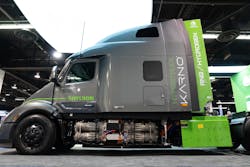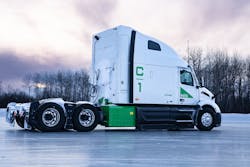Hyliion halts powertrain progress, pivots to stationary generators
On a strategic update call, Hyliion founder and CEO Thomas Healy announced due to component costs and lack of customer demand, sales and further development of the bolt-on Hypertruck ERX electric-natural gas powertrain for heavy-duty trucks would halt as the company mulls its future.
Healy said the company he founded in 2015 “will pause certain efforts such as securing new orders for trucks with our powertrain system and new development work until we have greater clarity on the outcome of the strategic review.”
The Austin-based powertrain maker said it will now shift focus to commercializing the fuel-agnostic Karno generator. Acquired from GE Additive in 2022 for $37 million, Karno can be used as a generator for mobile and stationary applications, with 20 different fuel options, including diesel, biofuel, CNG, propane, hydrogen, and even ammonia.
“We expect [Karno] to compete effectively in the stationary generator market due to superior operating characteristics, including high efficiency as well as low emissions, maintenance and noise levels,” Healy stated on the call. “We expect that the Karno generator will address the additional demands being placed on electric infrastructure and will be a preferred solution in existing generator markets.”
Hyliion still plans on completing assembly of the 30 planned production trucks by the end of the year. These are Peterbilt 579 sleeper trucks equipped with the ERX, short for Electric Range Extender, which use the Cummins’ natural gas ISX12N engine as an onboard generator, and also employ Meritor's e-axle. The company claims the ERX can alone supply 75 miles of zero-emission range; with the ISX12N, a Hypertruck could travel 1,000 miles (producing near-zero emissions) before needing to replenish its CNG fuel tank.
There was no mention on the call of the Hyliion Fuel Cell, which instead of a natural gas generator, would run off fuel cells developed by Hyzon. Healy previously spoke on that prototype: “Development went really well; the vehicle is actually up and running.” With the ERX development paused, that project does not have much hope.
See also: Hyliion to buy fuel-agnostic GE generator project
What led up to this?
In June, Hyliion noted to investors that for the hybrid technology to become a viable solution for fleets, the ERX would need to address three things. First was certification from the California Air Resources Board. The company also wanted to develop a day cab version and streamline powertrain sales and integrating with OEMs.
In September, CARB did hand down a Dual Executive Order to certify both the ERX and Cummins’ 15-liter ISX12N. This meant the pairing met California emissions standards as a near-zero emission vehicle (NZEV) under CARB’s Advanced Clean Truck (ACT) and Advanced Clean Fleet (ACF) rulings, and customers could receive a $40,000 incentive to purchase a Hypertruck.
“We needed this CARB certification in order to be able to get those $40,000 credits under the Inflation Reduction Act,” Healy explained to Fleet Maintenance Sept. 21. The final milestone, expanded fleet trials, had also begun.
“We see that as being the catalyst for really pulling in sales for the product, because fleets want to try them a little bit before they buy,” Healy continued.
That prompted Fleet Maintenance to ask at the time if Hyliion was now in “the homestretch.” Healy replied, “Very much so…and we are building the production trucks right now.”
Before Hyliion could finally materialize—and commercialize— a plan eight years in the making, they came upon a chasm of market forces too deep and wide to overcome.
On the Oct. 11 call, Healy said that “Companies are extending commercialization timelines amid various development challenges,” and there is a more “conservative level of interest” from fleet customers than anticipated. “Consequently, sales remain low and many companies are facing financial difficulties,” Healy noted.
This impacts Hyliion’s long-term profitability because instead of volumes scaling up and costs coming down, the opposite is happening.
“The cost of procuring powertrain components is increasing due to the limited number of suppliers and low production volumes for key components,” Healy said.
Volatile economic forces have also put Hyliion on its heels. “Inflation is also driving higher component costs and increasing the cost of our operations,” Healy said.
All this adds up to Hyliion hitting the brakes before crossing the point of no return.
“Current market conditions are unfavorable and there is no assurance that we will be able to raise additional capital on acceptable terms now or in the future given these dynamics,” Healy said. “The company believes now is the right time to consider all potential options for our powertrain business to ensure we are effectively deploying our capital and our strong cash position in the interest of our shareholders.”
See also: Hyliion founder on hybrid truck benefits; roadmap to hydrogen
What now?
This strategic review process could mean a few things for Hyliion. The best case is that Hyliion finds additional investors to address any powertrain development issues and that this is a small setback. This is an unlikely scenario given Healy’s statements and the powertrain’s classification as near-zero.
The ACT rules for zero-emission day cabs begin in 2027, requiring 10% of a fleets’ work trucks, day cab tractors, and buses with three axles to be ZEVs. That steps up to 25% in 2030 and 50% by 2033. But the Hyliion ERX solution is classified as near-zero, so it is unclear how that makes a difference. Hyliion was asked for clarification, but a spokesperson was not able to comment beyond what was said during the 7-minute conference call.
Whatever Hyliion’s plan was, fleets’ interest in the ERX and electric vehicles overall has not been what was needed to raise the capital to develop a day cab version.
Another option Hyliion has is to find a buyer for the powertrain intellectual property and assets and use that capital to commercialize the Karno technology. Healy spoke highly of Karno’s potential on the September call with Fleet Maintenance, noting its versatility and that unlike Cummins’ 15-L fuel-agnostic engine, “it is truly fuel-agnostic,” as it requires no component swaps, unlike the Cummins’ engine.
“One minute, you can be piping in natural gas, the next minute, you can pipe in hydrogen, and it's just going to seamlessly start running on hydrogen,” Healy explained. “You can even do a mixture of the two—it really doesn't care what fuel you're putting into it.”
Healy said this could be vital during an emergency, when a fleet or hospital, for example, cannot obtain natural gas but can source propane.
In non-emergency situations, Healy posted that fleets could deploy a fixed Karno generator to supply additional power to charge their electric vehicles.
“When people are trying to go deploy chargers today, they're getting told by their utility that it's a three-year lead time before they can get access to a grid hook-up, because they're asking for so much power,” he explained. “We can just come in and very quickly and give them an electricity hookup.”
This is actually promising in the near-term. Renewable energy sources such as wind and solar can be undependable, and there are no guarantees states pushing electric trucks will be able to scale infrastructure to charge more than a few truck at a time at every place that need to.
If the Karno generator can indeed run off 20 fuel types, it would a solution akin to Doc Brown’s futurized DeLorean that runs off garbage. And if renewable natural gas is used, fleets charging EVs could possibly reach net-negative emissions. OK, that’s not likely, but theoretically possible.
Finally, the third option is sell everything off wholesale or piecemeal to whoever will buy the IP. The stock (NYSE: HYLN) is half what it was before the call, dwelling at $0.60 per share as of the morning of Oct. 12.
About the Author

John Hitch
Editor-in-chief, Fleet Maintenance
John Hitch is the award-winning editor-in-chief of Fleet Maintenance, where his mission is to provide maintenance leaders and technicians with the the latest information on tools, strategies, and best practices to keep their fleets' commercial vehicles moving.
He is based out of Cleveland, Ohio, and has worked in the B2B journalism space for more than a decade. Hitch was previously senior editor for FleetOwner and before that was technology editor for IndustryWeek and and managing editor of New Equipment Digest.
Hitch graduated from Kent State University and was editor of the student magazine The Burr in 2009.
The former sonar technician served honorably aboard the fast-attack submarine USS Oklahoma City (SSN-723), where he participated in counter-drug ops, an under-ice expedition, and other missions he's not allowed to talk about for several more decades.

